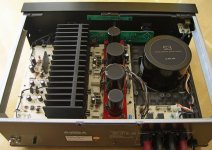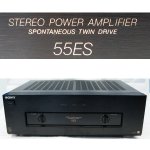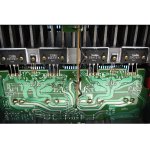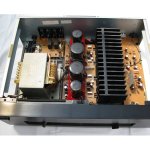mikeks said:
A resistive load for the first stage is a bad idea because it reduces the source impedance ''seen'' by the second stage, and, therefore, compromises current transfer from first to second stage.
This is the mechanism by which overall foward path gain is drastically reduced when changing from an actively loaded first stage to a resitively loaded one.
In this , I stay in complete agreement with you.
My last post only purpose , is of a practical way to check the REAL input impedance of the VAS-TIS , in real world conditions of operation ( my preferred conditions )... 😉
Tube_Dude said:
In this , I stay in complete agreement with you.
My last post only purpose , is of a practical way to check the REAL input impedance of the VAS-TIS , in real world conditions of operation ( my preferred conditions )... 😉
Easy: load down interface with large resistor, whose value you reduce until overall foward path gain falls exactly by half.
The impedance modulus at the interface (and at the test frequency) is then equal to the value of the resistor. 😎
mikeks said:
Easy: load down interface with large resistor, whose value you reduce untill overall foward path gain falls exactly by half.
The impedance modulus at the interface (and at the test frequency) is then equal to the value of the resistor. 😎
Obviously! 😎
Power output BjT Devices be broken again and again - unknown Reasons
The schematic is here:
Sony TA-N55ES Manual - Stereo Power Amplifier - HiFi Engine
One of the reasons, that I note, are follow:
1) Counterfeits/copies (like iSC) for 2SA1295 and 2SC3264 resp. 2SA1216 and 2SC2922
2) unwanted oscillation occurs in the mode without output power devices (3-4MHz)
Which experiences are present in the meantime?
In the schematic I note, that these capacitors are in use for compensation:
C329 between inv. and non inverted input
C305 parallel at NFB resistor (voltage gain factor ~160)
C303/C308 (lead-lag compensation - go to
http://www.analog.com/static/imported-files/application_notes/AN-257.pdf
for understanding)
Most suspect is for me C329, because at the same place just this capacitor in an Onkyo integrated amplifier caused unwanted oscillations and damaged output power transistors - go to the PDF attachment.
The German thread regarded Sony TA-N 55ES with STK3102-III about
Sony TA-N 55ES Problem, Hifi-Klassiker - HIFI-FORUM
don't provide any advices.
Thank you for your hints for remove the reason for repeated failures at the output.
under Post #807 about
http://www.diyaudio.com/forums/soli...or-families-audio-power-output-stages-81.html
I ask additional questions concerning dependable delivery sources of genuine stuff from SANKEN.
The schematic is here:
Sony TA-N55ES Manual - Stereo Power Amplifier - HiFi Engine
One of the reasons, that I note, are follow:
1) Counterfeits/copies (like iSC) for 2SA1295 and 2SC3264 resp. 2SA1216 and 2SC2922
2) unwanted oscillation occurs in the mode without output power devices (3-4MHz)
Which experiences are present in the meantime?
In the schematic I note, that these capacitors are in use for compensation:
C329 between inv. and non inverted input
C305 parallel at NFB resistor (voltage gain factor ~160)
C303/C308 (lead-lag compensation - go to
http://www.analog.com/static/imported-files/application_notes/AN-257.pdf
for understanding)
Most suspect is for me C329, because at the same place just this capacitor in an Onkyo integrated amplifier caused unwanted oscillations and damaged output power transistors - go to the PDF attachment.
The German thread regarded Sony TA-N 55ES with STK3102-III about
Sony TA-N 55ES Problem, Hifi-Klassiker - HIFI-FORUM
don't provide any advices.
Thank you for your hints for remove the reason for repeated failures at the output.
under Post #807 about
http://www.diyaudio.com/forums/soli...or-families-audio-power-output-stages-81.html
I ask additional questions concerning dependable delivery sources of genuine stuff from SANKEN.
Attachments
Last edited:
Images of this so called "Spontaneous TWIN Drive"
what means actually this term: "Spontaneous TWIN Drive" ???
In the attachment some JPG pictures:
what means actually this term: "Spontaneous TWIN Drive" ???
In the attachment some JPG pictures:
Attachments
Last edited:
Hello tiefbassuebertr.
I agree with you for a possible reason for repeated failure in power output.
Another possible cause is the different gain and vbe for the power transistors.It is important a selection for this parameters.
Not only a simple oscillations are the cause of "strange" broken, a simple 1 kHz square wave with 8 Ohm load should be checked at 1, 2, 5, 10 volts.If all is OK, another important stuff is a control over what happens with the output connected to a capacitor of 0.47 uF and 3000-4000 Hz square wave signal at 2-4 volts output.
Caution with this measure, in case of problems the output transistors are destroyed.
I agree with you for a possible reason for repeated failure in power output.
Another possible cause is the different gain and vbe for the power transistors.It is important a selection for this parameters.
Not only a simple oscillations are the cause of "strange" broken, a simple 1 kHz square wave with 8 Ohm load should be checked at 1, 2, 5, 10 volts.If all is OK, another important stuff is a control over what happens with the output connected to a capacitor of 0.47 uF and 3000-4000 Hz square wave signal at 2-4 volts output.
Caution with this measure, in case of problems the output transistors are destroyed.
The output stage is pretty similar to 630/650ESD. In a couple of cases I dealt with the overheated STK was the problem - it starts to oscillate at 1-2MHz and it leads to destruction of power drivers. Replaced the STK, attached diy heatsink, checked for bad solder joints and both amps are working for more than three years now without a problem.
- Status
- Not open for further replies.
- Home
- Amplifiers
- Solid State
- Sony TA-N55ES power amplifier



